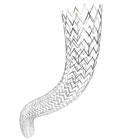Although there is significant long-term data in the use of drug-eluting stents in the coronary arteries, use of these devices in the peripheral vessels, specifically for femoropopliteal (above the knee) blockages, is less well-documented. Cook's Zilver is the only drug-eluting stent approved for use in the peripherals in the United States, and that FDA approval only occurred two years ago. So the presentation of long-term five-year data from the pivotal study is reassuring to physicians and patients alike.
While patency was slightly lower at the five-year mark than at four-years for both the Zilver and standard balloon due to disease progression and other causes, the divergence between the two therapies actually grew from year four to five, favoring the Zilver. Patency for standard balloon therapy dropped from 57.9% to 43.4%, a 25% rate of patency loss (14.5% absolute loss), whereas patency for the Zilver cases went from 75% to 66.4%, an rate of loss of only 11.5% from year four to five (8.6% absolute loss). These data speak to the long-term safety and efficacy of the drug-eluting device.
What remains to be seen in a major trial is how well a drug-eluting stent matches up against a drug-coated balloon. But between the Zilver data, and the IN.PACT drug-coated balloon studies presented today at VIVA 14, it seems that therapies other than the standard plain PTA balloon may well be the best practice therapies going forward.
Zilver® PTX® Drug-Eluting Stent Study Data Show Continued Patency at Five Years
November 4, 2014 -- Las Vegas, Nevada -- Five-year results from the largest and longest-running clinical trial of a drug-eluting stent for treating peripheral arterial disease (PAD) confirmed long-term patency for patients treated with Zilver PTX.
The results were presented today by Michael Dake, M.D., of Stanford University, at the 2014 Vascular Interventional Advances (VIVA) meeting.
Data from the Zilver® PTX® Randomized Controlled Trial of Paclitaxel-Eluting Stents for Femoropopliteal Disease showed 5-year primary patency of 66.4 percent in the superficial femoral artery (SFA) for patients treated with Cook's paclitaxel-eluting stent. This compares to 43.4 percent patency for patients with balloon angioplasty or provisional bare metal stent placement. [1]

Dr. Michael Dake |
"At five years, Zilver PTX demonstrated a 48 percent reduction in reintervention and a 41 percent reduction in restenosis compared to standard care," Dr. Dake told the VIVA audience. "Five-year data for Zilver PTX versus bare metal stenting confirm a sustained benefit for the paclitaxel-eluting stent. Zilver PTX continues to show benefit through five years with no late catch-up."
"Cook's commitment to providing clinical evidence of the effectiveness of drug-eluting devices in the peripheral vessels is unmatched. With this new data showing durable patency at five years, we're confident our Zilver PTX stent offers PAD patients a lasting benefit," said Mark Breedlove, vice president and global leader of Cook Medical's Peripheral Intervention clinical division.
The Zilver PTX Randomized Trial of Paclitaxel-Eluting Stents for Femoropopliteal Artery Disease was a 479-patient multicenter, prospective, randomized study. It was designed to evaluate the PTX stent as a treatment for peripheral arterial disease (PAD) in the superficial femoral artery (SFA).
Dr. Dake, a global principal investigator for the Zilver PTX trial, is a paid consultant to Cook Medical regarding the research and development of medical devices.
About Cook Medical
Since 1963 Cook Medical has worked closely with physicians to develop technologies that eliminate the need for open surgery. Today we are combining medical devices, biologic materials and cellular therapies to help the world's healthcare systems deliver better outcomes more efficiently. We have always remained family owned so that we have the freedom to focus on what we care about: patients, our employees and our communities. Find out more at www.cookmedical.com, and for the latest news, follow us on Twitter and LinkedIn.
Use and potential contraindications: The Zilver PTX Drug Eluting Stent is intended for treatment of de novo or restenotic symptomatic lesions in native vascular disease of the above-the-knee femoropopliteal arteries having reference vessel size from 4 mm to 7 mm and total lesion lengths of up to 140 mm per limb or 280 mm per patient. The use of this drug-eluting peripheral stent carries the risks associated with peripheral artery stenting including vascular complications, and/or bleeding events.
[1] Dake M. The Zilver PTX randomized trial of treating femoropopliteal artery disease: 5-year results. Presented at: Vascular Interventional Advances (VIVA); November 4-7, 2014; Las Vegas, NV.


